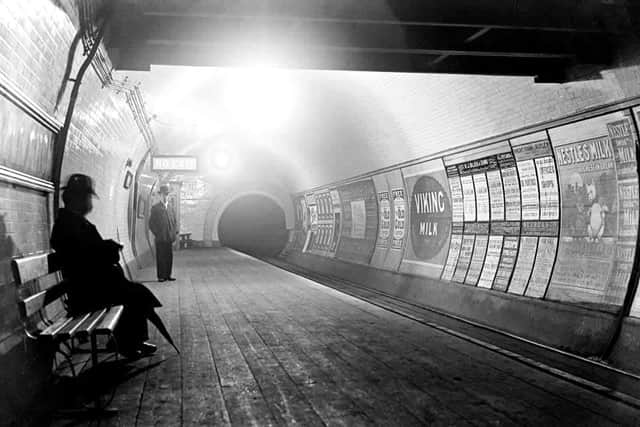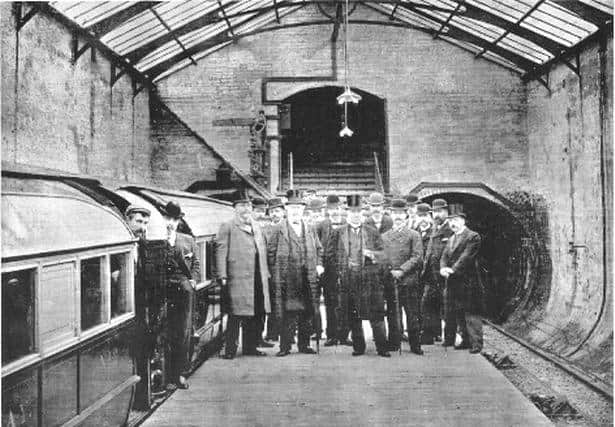The forgotten plan to build a subway system under central Edinburgh
In 1889, the Caledonian Railway Company, who once operated the now demolished Princes Street Station and various lines connecting the Capital, devised an ambitious plan to build a subway system connecting the city centre and Leith.
Glasgow’s famous looped subway came into being three years earlier, spanning more than six miles and extending north and south of the Clyde.
Advertisement
Hide AdAdvertisement
Hide AdEdinburgh’s underground railway would tunnel deep beneath Princes Street and Calton Hill on its way to Leith, with a station earmarked for the site of present-day Waverley Mall.
The town council met to discuss the plans for the first time on December 5, 1889. Almost immediately, however, they encountered a number of stumbling blocks.
While it was agreed that the majority of Leith’s residents would likely be in favour of faster communication to the Capital, those who owned property in Princes Street complained that the incessant rumbling and tremors below their shops would affect business and impact negatively on their general standard of living.
In a letter to The Scotsman, one former Princes Street proprietor wrote of vibration issues during the time the Scotland Street freight tunnel between Edinburgh Waverley and Canonmills was in operation.
They wrote: “It may be serviceable to state that I occupied a shop for several years at 24 Princes Street during the time that the railway tunnel to Scotland Street was in use.
"The vibration in my shop was so great that my attention was frequently called to the passage of trains by the shaking of goods in the glass cases.”
Construction experts responded to these fears to state that due to the nature of the strata there would be “no cause for fear of noise or vibration being caused along Princes Street”.


On the subject of ventilation, and using the recently-completed Mersey Railway Tunnel as an example, Caledonian Railway engineers said there would not be the “slightest difficulty” in ensuring a continuous flow of air into the proposed subway.
Opposition to the underground railway in some quarters was fierce. On January 17, 1890, a meeting of residents in the Calton ward was held in which it was agreed that any scheme to build a tunnel under Princes Street and Calton Hill and through Royal Terrace and Hillside Gardens would “Injure the amenity and commercial interests of the city”.
Despite a number of concerns, there was almost unanimous approval between the town councils of Edinburgh and Leith, and the Caledonian Bill was taken to Westminster.
Advertisement
Hide AdAdvertisement
Hide AdParliament debated the bill on nine occasions, eventually arriving at the conclusion that the potential benefits of the proposal did not outweigh the negatives.


Local historian Abbie Archer, who has studied the underground railway proposal in great detail, says there were two major reasons the scheme failed.
To build the subway, the engineers would have used cut and cover, a destructive method of tunnel building that would have resulted in a six metre wide trench being dug the length of Princes Street – an unpopular proposition.
Abbie said: “Firstly, the tunnel was cut and cover, meaning a deep trench would need to have been dug along Princes Street and second, the fact the line would use steam trains meant that smoke vents would need to be built to stop the tunnel being clogged with smoke and suffocating people.
"This was before electric traction and the fact it was intended to be connected to the mainline network meant they couldn't do what Glasgow did in the early days and use cable haulage.”
On March 27, 1891, the Evening News reported that Edinburgh’s bid to pip Paris and New York in building the world’s fourth municipal underground railway system was over.
A message from the Editor:
Thank you for reading this article. We're more reliant on your support than ever as the shift in consumer habits brought about by coronavirus impacts our advertisers.
If you haven't already, please consider supporting our trusted, fact-checked journalism by taking out a digital subscription at https://www.edinburghnews.scotsman.com/subscriptions.
Comments
Want to join the conversation? Please or to comment on this article.
